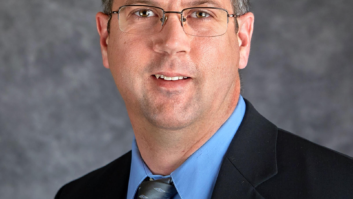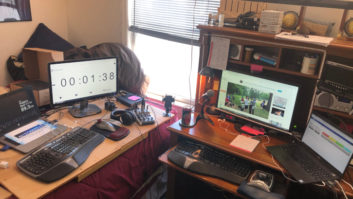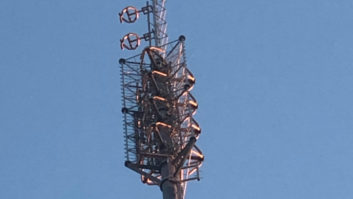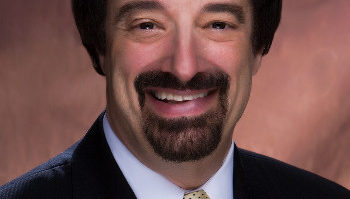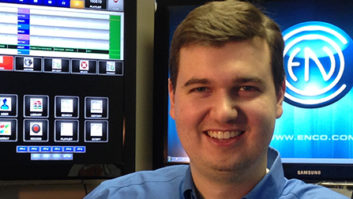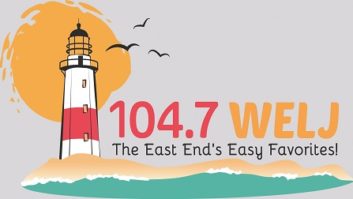Move the studios? A Capital Idea
Oct 1, 2004 12:00 PM, By Chriss Scherer, editor
Cumulus Broadcasting owns six stations in the Topeka market. Until the end of August 2004, KMAJ-AM, KMAJ-FM, KQTP-FM, KTOP-AM, KDVV-FM and KWIC-FM were in three different locations around town. The stations occupied these spaces for a long time, and much of the equipment had served its useful life after many years of heavy use. The move deadline was not set by leases, but rather the desire to have all the stations moved before the beginning of the fall ratings period in September.
Of the three locations, only one was leased. There wasn’t a pending lease expiration looming, but the desire to move into new studios was strong. Cumulus owned the other two buildings that were occupied and is now looking to sell those properties.
Only the beginning

The studio construction project was assigned to Dave Supplee of Cumulus Harrisburg because the Topeka stations rely on the services of a contract engineer. Supplee, who supervised the Cumulus Harrisburg studio project completed in early 2003, decided to take a similar approach to building the Topeka facility.
Supplee recruited the help of three other Cumulus engineers: Gary Zocolo of Youngstown, OH, Wes Davis of Jefferson City, MO, and Kevin Hawley of Toledo, OH. But before the Cumulus team got to work, Supplee contracted Lightner Electronics and Skyline Communications to get the project started.
Skyline Communications handled the initial wiring and cable runs for IT and audio. Later, a local IT installer handled some IT elements. Lightner Electronics terminated the multi-pair studio wiring to studios, punch block wall, racks and the IT punch block wall.
All the studios have a similar layout to the KMAJ-FM air studio.
All but one studio have a view to the street outside. This is the studio for KTOP.
The mic booms are mounted on pedestals with headphone jacks and volume controls. Mic controls are installed on flush-mounted panels.
The Middle Atlantic slide-out rack allows easy access to a tight space.
Two views of the rack room from separate hallways.
The on-air lights are mounted over the doors. The color contrast and flashing light increase their visibility.
The punch block wall was installed by Lightner Electronics.
By using contracted integrators at the start, the project could begin while Supplee focused on equipment orders and scheduling work crews.
Because of the heavy wear the equipment received in the previous locations, little was reused in the new studios. A few items, such as mic processors, STLs, one Audioarts console and some power amps, made the move. This was a welcome upgrade for the stations’ on-air staffs, and it also allowed the facility to standardize on certain equipment, eliminating the equipment hodge-podge.
The new building has five floors, which are jointly owned in a public/private venture. The first and fifth floors are office space, owned by a private landlord. The remaining floors are a city-owned parking garage. Cumulus considered leasing the fifth floor at the onset, but decided that the ground-floor location would provide better public visibility and a closer tie with the community than a lofty space would allow. It also makes the ground-floor air studios, with their large windows, a performance space for the on-air talent.
The windows in each studio were made by Industrial Acoustics, and each studio is an isolated box from the outside walls and ceiling. Being on the first floor, traffic noise from the street outside could have been bothersome. In addition, the parking garage directly above the studio space could have been a problem � car alarms, for instance. Now that the construction is complete, the isolated construction has proven to work well. In addition, the glass in the studios is ?� thick. This adds to the noise abatement, but also provides some additional security from the outside.
A perfect mix
The audio sources in the facility are a mix of analog and digital sources. Once a source enters a console or the audio router, it becomes digital if it was not already.
The Audioarts router is configured with all analog inputs and almost all digital outputs. The four analog outputs that are provided are for the one console that does not accept digital inputs, which is the Audioarts R-5 that was brought from a previous facility.
Supplee noted that one time-saving element of the router was its IP and not serial control. The team was able to use prefab CAT-5 cables and an Ethernet switch to make the connections, saving time from creating a serial network and attaching DB connectors.
The entire facility relies on a 125kW generator for back-up power. In addition, the studios have a large UPS to provide uninterrupted power before the generator starts, saving the studio equipment from the momentary power interruption during transfer. By using a central UPS, the unit can be located in its own room with its own ventilation. While a UPS for each studio would provide some redundancy, this would require additional storage space and cooling needs. Also, by locating the UPS in its own room, the cooling can be set only for the UPS, without creating an uncomfortable environment for the staff. It also removes a potential source of noise from the studio space.
With regard to noise sources in the studios, there are none. All the PCs are in the rack room and are accessed through KVM (keyboard, video, mouse) extenders. There are also no televisions in any of the studios. Instead, the general-use PCs have a TV tuner card. The audio from the general-use PC is routed to the studio console, so the TV audio is available when needed. Accessing the TV through the PC eliminates another piece of clutter in the studio.
The on-air lights are standard lighting fixtures selected by the architect. Mounted into protruding drywall boxes over the door, the flashing red lamp provides a high contrast to the white and bright green walls and are clearly visible.
Studio ops
Each studio has a source-select panel that provides a simple method of bypassing the console to feed the output of the Scott Studios computer directly to the processing and STL. The panel also selects the feed into the Voxpro to select any combination or a mix of host and caller audio.
The audio playback system is a Scott Studios SS32. Relying on a Windows 2000 server at its hub, there are eight studio computers and a dispatch computer with a 1TB RAID array. Audio files are loaded to a local machine and then copied to the other studio machines as needed for playback. All audio is played from a local machine. If a file is missing or corrupt it will play back from the server if needed. Each local machine can store 200GB.
In preparation for the move, jingles, liners and other audio files were copied from the old DOS system to the new server using a software utility. The music library was loaded by Scott to the new systems.
Each studio computer has dual sound cards with Audioscience ASI5111 cards. The dual cards allow talent to voice track to any system from any studio. Al Schermeister of Scott Studios handled the Scott Studios integration.
After several weeks of planning and building, all six stations were moved in a five-day period. The first two stations, KWIC-FM and KQPT-FM, moved in on Aug. 26. KMAJ-AM and KTOP-AM moved in on Aug. 28 and 29. KMAJ-FM and KDVV-FM moved in on Aug. 31. As the fall ratings period approached, the final touches were put into place for an open-house celebration that would host several invited guests, including the Mayor of Topeka and the Governor of Kansas. In a facility that is blocks from the Kansas state capital, Cumulus has completed a showcase with renewed ties to the community.
Equipment List
Adobe Audition
Aircorp Pro Announcer 500PH mic preamp
ATI DDA206 digital distribution amp
Audio Science 5111
Audioarts ADR 32 router
Audioarts D-70 console
Audion Labs Voxpro editor
Audioscience sound cards
Avocent Longview KVM
Behringer PRO-XL HA4700 headphone amp
Belden 8451
Bitree patchbay
Broadcast Tools ACS 8.2 switcher
Broadcast Tools AVR-8
Broadcast Tools Silence Monitor III
Broadcast Tools SS 16.4 switcher
Comrex Matrix
Crown D-75 power amp
Denon DN-950FA CD player
Electro-Voice RE-20 mic
ETA Systems PD8
European Cabinetry Unlimited Furniture
Furman PL-Plus power conditioner
Geffen Extendit USB 400S
Gepco 552624, E131675, 61801EZ and 552608
Hafler P1500 power amp
Harris CD 2001
Henry Engineering Superelay
Henry Engineering Twinmatch
HHB Burn-it Plus CD recorder
Industrial Acoustics windows
Inovonics 530
JBL 4401A
Krone punch blocks
Lucid AD 9624
Marti STL-15C
McCurdy AT2656
Middle Atlantic racks, shelve, blanks and screws
Moseley Starlink SL9003SQ
Neutrik NP3C 1/4″ TRS
O.C. White mic booms
Powerware 9330 UPS
Radio Systems B.O.B.
Radio Systems DA-4x4a distribution amp
RAM SR64
Sage Endec
Scott Studios SS32
Shure KSM-44
Sony MDS-E12
Sony PCM-R500 DAT
Switchcraft ZA3MB and ZA3FB XLRs
Symetrix 528E mic processor
Telos 1×6
Primary Dealer: BGS





